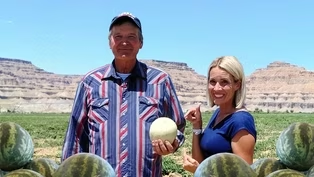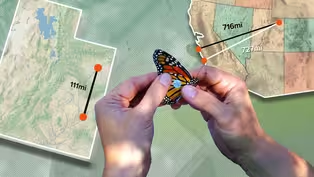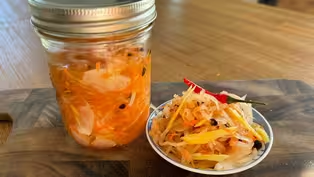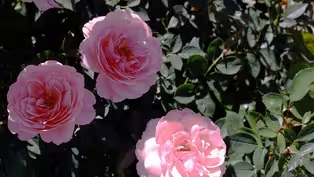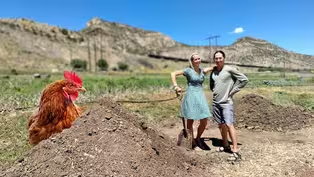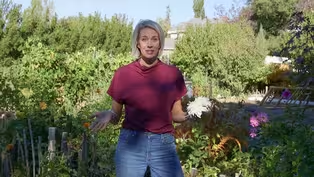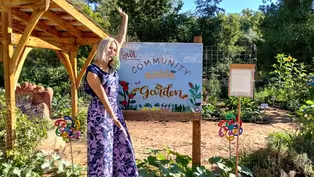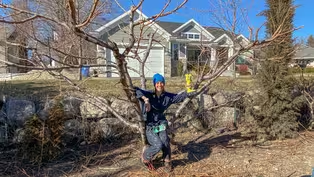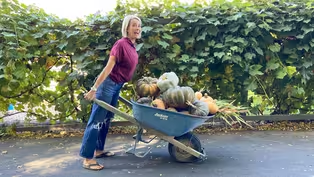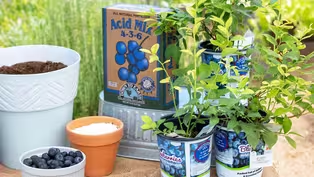Modern Gardener
Mountain Man Flowers
Episode 82 | 8m 39sVideo has Closed Captions
Stephen Workman talks about what it's like growing a flower farm in the mountains!
A visit to Mountain Man Flowers, a flower farm located in the Wasatch Mountains at Zone 4b (sometimes 5a). Stephen Workman, the owner and farmer behind Mountain Man Flowers, talks about growing in a short season, planting schedules, flower varieties, and soil amendments.
Problems playing video? | Closed Captioning Feedback
Problems playing video? | Closed Captioning Feedback
Modern Gardener is a local public television program presented by PBS Utah
Funding for Modern Gardener is made possible in part by Merit Medical and Red Butte Garden & Arboretum.
Modern Gardener
Mountain Man Flowers
Episode 82 | 8m 39sVideo has Closed Captions
A visit to Mountain Man Flowers, a flower farm located in the Wasatch Mountains at Zone 4b (sometimes 5a). Stephen Workman, the owner and farmer behind Mountain Man Flowers, talks about growing in a short season, planting schedules, flower varieties, and soil amendments.
Problems playing video? | Closed Captioning Feedback
How to Watch Modern Gardener
Modern Gardener is available to stream on pbs.org and the free PBS App, available on iPhone, Apple TV, Android TV, Android smartphones, Amazon Fire TV, Amazon Fire Tablet, Roku, Samsung Smart TV, and Vizio.
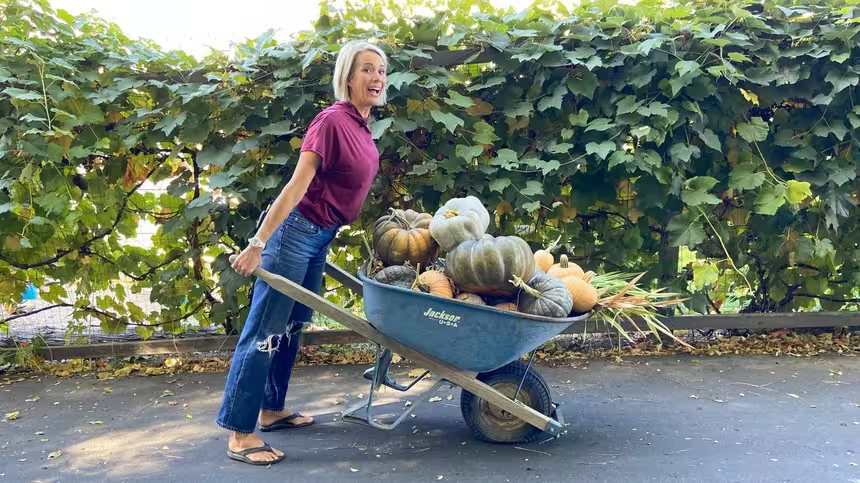
Modern Gardener
Subscribe to the Modern Gardener YouTube channel for more videos and information on gardening, and share your gardening tips and stories in the comments section. Can't wait to GROW with you!Providing Support for PBS.org
Learn Moreabout PBS online sponsorshipMore from This Collection
See beautiful gardens and learn about local gardening organizations! Come along with us, as Modern Gardener features and supports those committed to educating and enlightening Utahns about gardening for our unique region.
Everything to Know About Monarch Butterflies
Video has Closed Captions
Learn about one of North America’s most iconic species and the challenges facing it. (11m 34s)
How to Track a Monarch Butterfly
Video has Closed Captions
A pea-sized sticker is helping researchers track Monarch butterflies. (4m 14s)
Can Roses Save Water and Clean the Air?
Video has Closed Captions
Flipping your strip with roses. (7m 8s)
Composting with Chickens and Beer
Video has Closed Captions
Learn how to compost with chicken tractors and spent beer grains! (7m 22s)
What's Happening in My Garden in October?
Video has Closed Captions
Here's what's going on in my garden during the month of October. (2m 19s)
Video has Closed Captions
August means you're living in the harvest! (4m 44s)
What is Moab's Community Nibble Garden
Video has Closed Captions
A tour of the Youth Garden Project's 'Nibble Garden' a free-for-all community garden. (3m 34s)
Video has Closed Captions
We show you how to properly prune a peach tree for great peaches and a healthy tree. (10m 8s)
Growing Blueberries in Utah's Alkaline Soil
Video has Closed Captions
Sheriden Hansen of USU Extension is here to teach us about growing blueberries in Utah. (10m)
Providing Support for PBS.org
Learn Moreabout PBS online sponsorship- [Ashley] Last September, we took a trip to Mountain Man Flowers, a flower farm located just outside Morgan, Utah in the Wasatch Mountains.
- [Stephen] There are 300 sunflowers in this space.
- Just in this space alone.
- Yeah.
- That is insane.
- Yeah.
(rooster crowing) (Stephen laughing) - The rooster was like, woo-hoo-hoo!
(both laughing) Sunflowers.
- We met with Stephen Workman, the owner of Mountain Man Flowers to learn more about what it takes to grow a flower farm.
So, if you're blessed with an acre of land or even a quarter of an acre of land and you wanna start a flower farm, it's a ton of work as I understand.
- It is.
- Can you talk to us a little bit about the amount of work?
- Yeah.
So, a single person would find themselves quite well worked with just a quarter acre of land.
In flower farming, we grow things quite close together, and so you can pack a whole lot of flowers in a quarter acre.
It just depends on what you have in yourself and how much work you're willing to put in a week.
I probably put in anywhere from 60 to 80 hours in a week right now.
- Wow.
- Because for the most part, it's just me.
I get a little bit of help here and there from family, but mostly it's just me.
- Can you tell us a little bit about your background and how you got started flower farming?
- So, it all goes back to a single rosebush when I was about eight years old.
We'd just moved into a new house, and whoever lived there before did an excellent job at taking care of their roses.
After that first year, we didn't know anything about caring for flowers, so it never flowered again and eventually died.
(Stephen laughing) And it haunted me all of my life.
I always wanted to be able to grow roses.
And so when I moved back to Utah after living in San Francisco and New York for many years, I started to help my parents with maintaining this property.
And so, the first thing I wanted to do was just start anywhere I could find a spot.
I started to grow roses and then more roses and more roses.
And then I started to branch out into other flowers and that's how we got to here.
- [Ashley] That's awesome.
Yeah.
- So, we are a 4b climate, which is a very short growing season.
Sometimes it's a 5a, just I treat it like a 4b.
So a lot of winter maintenance, so that they make it through our really harsh winters.
And then as soon as the spring comes, hustling to get it started as fast as you can, because it's such a short window.
- Can you talk to us a little bit about how you plan to have a product for most of the year?
I mean it's September, and you have amazing flowers right now.
- Yeah.
So, there is what I would call the June dread, which is right after your tulips end and you're waiting on your snapdragons.
A lot of first year farmers will experience that gap in the early part of spring when you're just starting to get a lot of interest in your flowers, suddenly everybody wants your flowers and you're like, "I don't have any."
- [Ashley] Yeah.
- So, planning ahead for that, there's a lot of things you can do.
That's what I'm doing right now actually is planning for that time.
And I'm doing that with what's biennials.
So, it's gonna be your foxglove, delphinium.
- [Ashley] Okay.
- But they fill in that gap.
I'm hardening these off now.
These are all foxglove.
You can get flowers sometimes on your first year, but they're not gonna be good quality.
At least not for me because I have such a short growing season.
So, it's better for me to put them in the ground now.
I have a few weeks to get their roots established and they will over winter and produce great flowers for me during that gap when you really need flowers between May and beginning of July.
- Okay, cool.
- So, understanding when your flowers are going to come on is gonna help set you for success, so you don't get frustrated 'cause if you don't know that it takes two years to get a hollyhock to flower, you may give up on that plant after the first year 'cause it didn't give you any flowers.
- Right.
- So, taking the time to research how long flowers take to mature is gonna help you know when to start them.
Fall is a great time to start plants 'cause they're not having to battle the heat and they can just establish their roots.
- [Ashley] Okay.
- So, I love planting in the fall.
So, we have all this stuff that needs to go in.
It's a lot that needs to go in.
- For the fall - But now is a great time to get it in.
- Okay, that's awesome.
That's good to know.
And then it will over winter and then it will just have amazing blooms late spring.
- We hope.
- Yeah.
(Stephen laughing) - Cool.
Is there a time of year when you start to really plan out the whole year and like get out the journal?
- Yeah.
So, all growing season long, I'm taking notes and getting ideas in my head on how I want things to go.
The day after Christmas is a great day to just decompress from the holidays and take everything you've learned from the season and start to plan.
So, that's a perfect time to start thinking about your garden, how you want it to lay out, how many of certain flowers you want to grow.
And start your seeds a week after the day after Christmas.
I'm starting seeds as early as January 1st.
I'm starting my lisianthus seeds, 'cause those take anywhere from six to seven months to get to flower.
So, when you're thinking about buying seeds, you wanna have your seeds already by then because if you're doing your plan and suddenly, oh, I wanna have this many snapdragons and I better go buy them.
They might be sold out.
And the good rule of thumb, if it's blooming that's when it's time to go buy seeds.
So if my cosmos are blooming now I better go get my cosmos now for next year.
If I want to get the cosmos I want.
And I did finally get one I was really hoping for, which is called a pink lemonade one, that's from Baker Creek Seed.
And I can't wait to grow it.
(Ashley laughing) But I couldn't get it last year because by the time I wanted it, it was sold out.
- It was gone, right.
- [Stephen] These are all the different kinds of cosmos.
I'm just trying different ones seeing which ones I like, I love them.
- Oh, look how gorgeous that is!
And I know that you have to sustainability efforts.
Can you tell us about that?
Like you were saying you don't use any kind of synthetic pesticide?
- No.
So I, one thing that I've really come to appreciate and come to grow into, is how close you are to nature.
Especially when you're growing flowers it's one thing when you're growing vegetables, but to be surrounded by that many bees, you quickly realize that you're creating this environment that is attracting a lot of ecosystem because you're it's food.
That's the source of food for the base of our ecosystem is flowers.
And so, because I am attracting all those things I take it very seriously what I'm doing to everything that's coming here.
So I don't, I refuse to use pesticides and I don't use herbicides.
That means I have more weeds.
I've come to peace with that.
(Ashley laughing) - Come to peace with the weeds.
- Yeah, so one thing that I do is every week I spray what is called a compost tea.
I use a system called Growing Solutions.
You can make compost tea in a bin just on your own, just by putting compost, water, letting it sit and then siphoning off the water.
We always bring in more cow compost because it's one of the most neutral manures that you can use on any kind of plot that you're trying to build up the soil.
- Okay.
- Utah has a lot of clay in it so it needs to be introduced to a lot of organic material.
I still continue to add, every year, more compost.
And this year I'm going to be doing a soil test and they can tell you exactly what you might be missing.
- Okay.
So do you do that?
We're in the first week of September right now.
So when do you do that?
- Now.
- Okay.
- Now is the right time to do that because even though I may not actually get those amendments on until October, I want the time to have to, if I need to go out and buy amendments, if I need to order certain things in I wanna be able to have those by October when I'm ready to redo this field.
- [Ashley] What kind of challenges did you face within that first year and lessons learned from moving forward?
- The weeds.
Especially at the end of the summer.
You think they're okay.
You kinda leave 'em alone.
Then as soon as that summer heat hits and you get some summer rain, they shoot up.
So get on those early on.
Especially in Utah, we have a lot of drought resistant weeds that are going to survive your flowers.
- And you seem like a very hard worker.
- Yeah.
I mean you can't, you can't not be.
But I love to work hard and the flowers make it all worth it.
So while it's a lot of work, I don't think it's work to be afraid of.
- [Ashley] We hope you enjoyed this video and learned some useful flower farming tips from Stephen.
Please leave your comments and questions below and don't forget to subscribe to "Modern Gardener."
(gentle music)


- Home and How To

Hit the road in a classic car for a tour through Great Britain with two antiques experts.












Support for PBS provided by:
Modern Gardener is a local public television program presented by PBS Utah
Funding for Modern Gardener is made possible in part by Merit Medical and Red Butte Garden & Arboretum.
